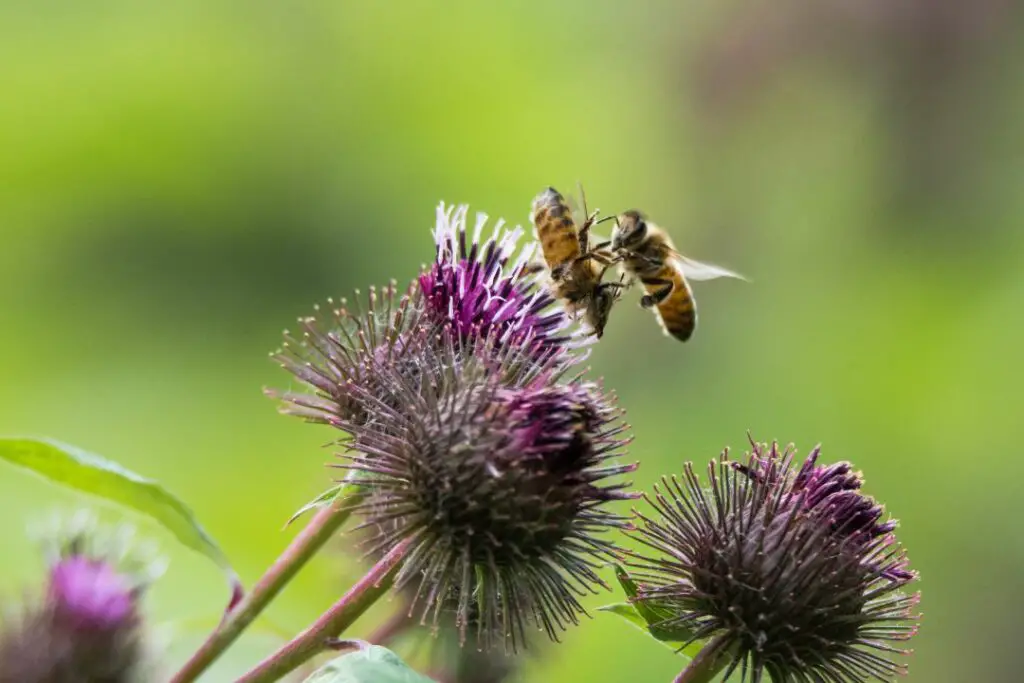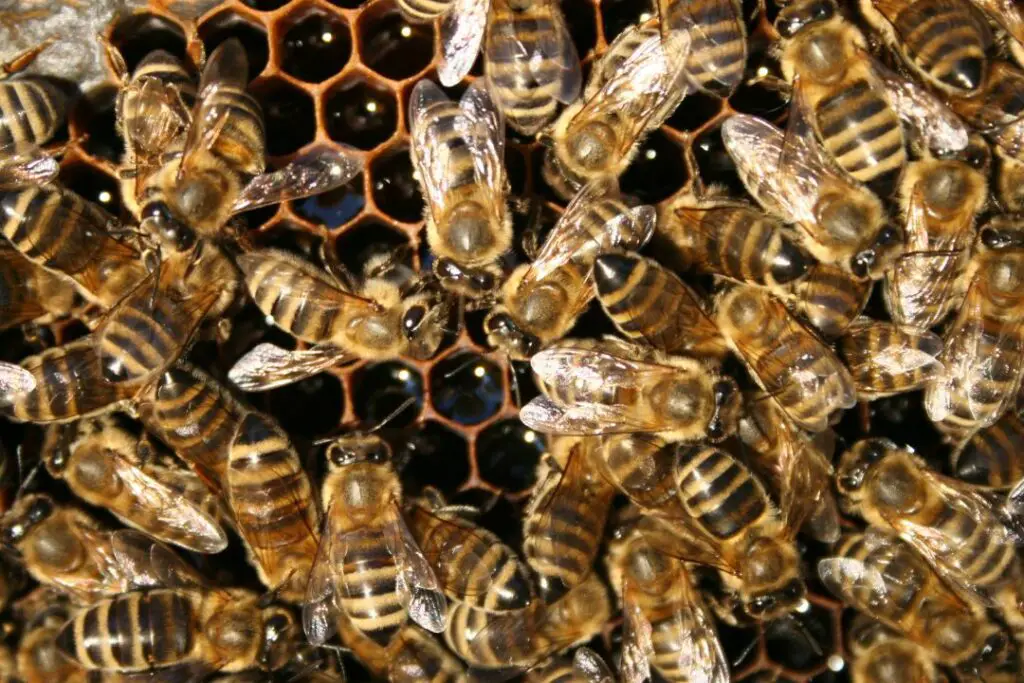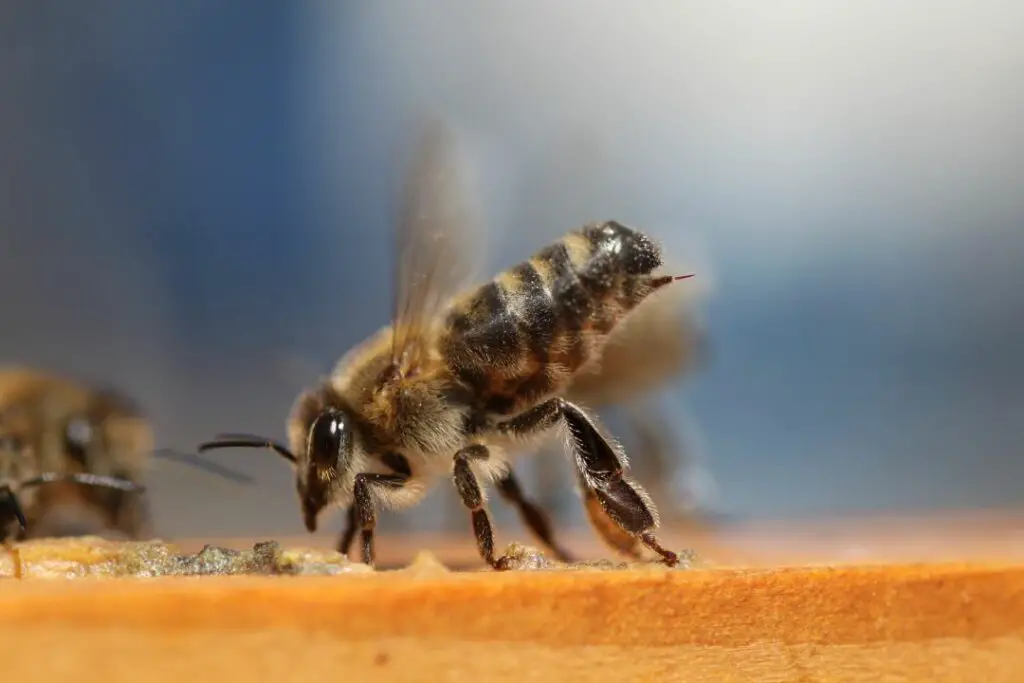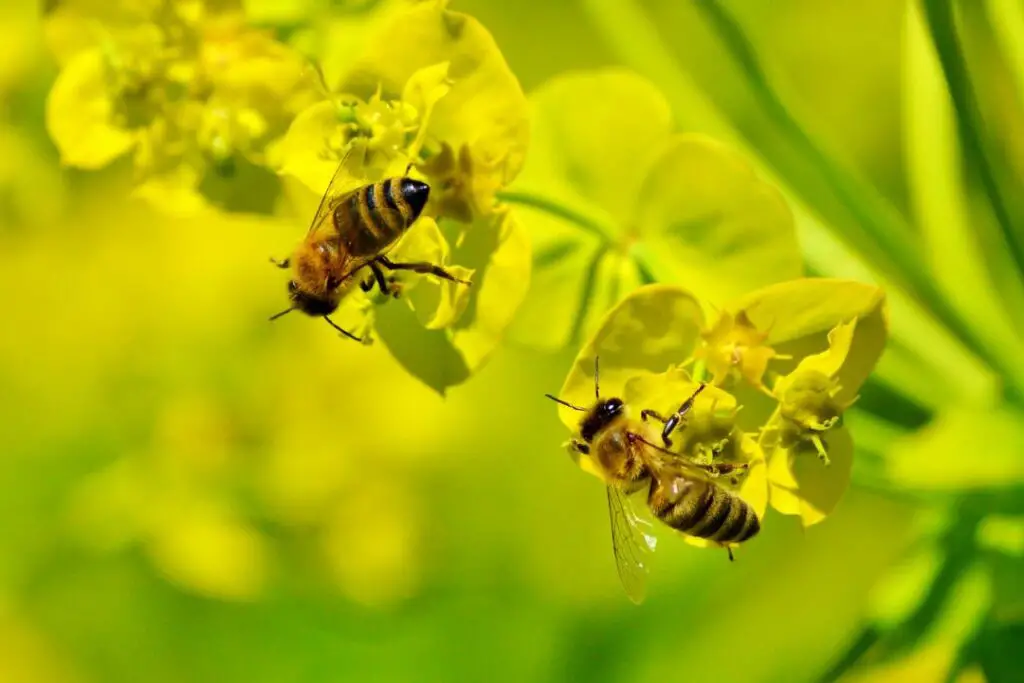Yes, bees can and will sting other bees; whether defence or attack, they’re not afraid to turn their barbed stingers on their own species.
But what leads a bee to sting another bee, and what happens to the bee afterwards?
Let’s look closer at the deadly side of an intra-species conflict and get the full low on what turns these normally docile insects into killers.

Why Do Bees Sting Each Other?
Believe it or not, bees can fight and sting each other for several reasons. From fighting for food to a full-blown invasion, let’s see what causes bees to fight with deadly consequences.
Fighting For Resources
During a nectar shortage (sometimes called nectar dearth), honey bees from different hives can fight for precious resources in the area.
This happens when one hive or nest gets dangerously low on food stores. In this extreme situation, they’re forced to look to other unlikely food sources in the form of other hives.
These are known as ‘robber bees’ and can come as just a few bees or an entire colony. Their sole purpose is to find and steal the calorie-rich honey deep within the hive, but it’s no easy task.
Guard bees are on the lookout for these unwanted intruders and will bite and sting any bees they find who aren’t part of the colony.
*Interesting fact – Bees release pheromones that help other bees identify if they’re part of the same colony and not just here to rob the honey.
Invading A Hive
In rare cases, bees have been seen to actively invade other hives with one goal: killing the queen.
These are normally small swarms with little to no chance of surviving the winter unless they intrude on and take over an active colony. This tends to be a vicious fight to the death, with many of the invaders being dispatched by bees at the entrance to the hive.
If some bees reach the queen in the rare case, she will be quickly swarmed and killed, with the invading queen taking her place. The remaining bees have often been observed to accept the new queen, combining the two colonies.
When A New Queen Bee Takes Over The Colony
When a new queen (often referred to as a “virgin queen”) emerges from her cell, she emits a series of high-pitched sounds known as “piping.” This sound serves as a challenge to other potential emerging queens.
Her primary objective is to secure her reign. So, she will actively seek out other queen cells. Once located, she will use her strong mandibles to tear open the side of the unmerged queen’s cell, a process called “chewing out,” before stinging and killing the developing queen inside.
If two or more virgin queens emerge at once, they engage in a gladiatorial battle to the death. These duels involve intense grappling and attempts to sting each other, with only one winner emerging victorious.

Which Bees Can Sting
Not all bees are equal; some aren’t equipped with a stinger. Let’s look at the different kinds of bees in the hive and their stinging capabilities.
Female Bees
Female worker bees make up the majority of bee colonies; they look after young larvae, collect food and protect the other inhabitants from predators and robbers.
They’re equipped with a barbed stinger they use for defence, with many workers taking up roles as guard bees, tasked with defending against some of the unwanted guests we learnt about earlier.
Male Bees
Otherwise known as drone bees, these males of the species are tasked solely with locating and mating with a queen from another colony.
While they may buzz around unwanted attackers, they cannot sting and can’t cause any real damage, unlike their female counterparts.
Queen Bee
The queen bee lays eggs to bolster the colony’s population. Each colony only has one queen at a time, and her pheromones guide and direct all bees inside a hive or nest.
She’s equipped with a smooth stinger often used to dispatch other virgin queens when she takes her throne.

What Happens When A Bee Stings Another Bee?
Now we know what can cause bees to turn on each other, let’s find out exactly what happens when bees sting other bees.
Sting Mechanics
Unlike when stinging humans or other mammals, a honeybee does not usually lose its stinger when it stings another bee.
A bee’s exoskeleton is not as thick or elastic as mammalian skin, which lets the bee retract its barbed stinger without injuring its abdomen.
This same barb can get stuck in human and mammal skin, causing a rupture in the abdomen and catastrophic injuries as they try to free themselves from the sting site.
Venom
The venom from the sting can paralyze or kill the victim. It contains various toxins, including melittin, which can damage the cellular structure of the stung bee.
Worse yet, because the bee can retract its stinger, it can sting multiple times, meaning an extra dose of deadly toxins.
While the victim may be able to fly away in the short term, the venom will quickly begin to take effect before grounding the bee to expire eventually.
Alarm Pheromones
When a bee stings, it releases alarm pheromones. These chemicals signal to other bees in the vicinity that there’s a threat, prompting them to become more aggressive and alert.
If an intruder bee gets stung inside or near the hive, these alarm pheromones can attract more bees to defend the hive, leading to many more stings.
Do Bees Ever Accidentally Sting Other Bees?
We’ve never seen a bee accidentally sting another bee, and as a general rule, bees that share a nest will not sting each other. However, some extreme cases can lead to unintended stings.
- Guard Bees: Guard bees stationed at the hive’s entrance are responsible for keeping out intruders, including bees from other colonies. While fending off a perceived threat, they can mistakenly sting a member of their colony.
- Queen Duels: When new virgin queens emerge from their cells, they seek out and attempt to kill rival virgin queens. During these duels, they might accidentally sting worker bees that get in the way.
- Overcrowding & Stress: Extreme overcrowding, other stressors and heightened aggression can lead to accidental stings.
- Handling: Bees can become agitated when beekeepers inspect a hive or handling frames. In the commotion, bees might inadvertently sting each other.
While these scenarios are possible, it’s important to note that bees generally avoid stinging other bees from their colony. Stinging is typically reserved for larger threats where the barbed sting (which leads to the bee’s death when used on fleshy animals) wouldn’t be left behind.

In Conclusion
Now we know bees can sting other bees for various reasons, from defending their food sources to securing their place as the new queen of a colony.
If you’ve enjoyed this read, then make sure to check out our interesting read on whether beekeepers get stung by their bees.
Or check out our other great articles below about the fascinating world of bees in your garden.





